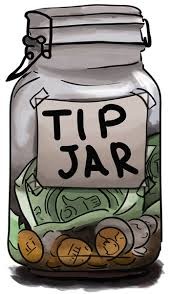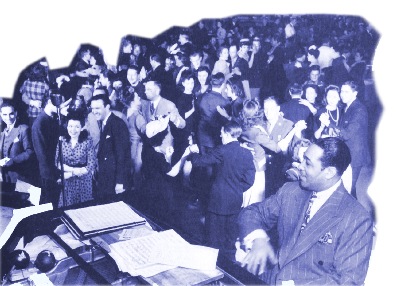
Duke Ellington and his Famous Orchestra
Live performances, 1938-63
Recordings, transcriptions and broadcast rarities show the band's live performance was distinctly different from their studio sound.
Highlighting the 1940 <I>Fargo, North Dakota concert</I>, this series also features fresh restoration from broadcast tapes of the “Birthday Sessions,” recorded at McElroy's Ballroom in Portland, Oregon, April 1953 & 54.
This radio series of dynamic live performances was dedicated my late aunt, Bee Pine. A long time member of the Ellington Society, she was the most committed Ellington enthusiast I’ve known. Bee once drove all night and half way across the state of Arizona to attend a live performance by Duke and his orchestra.
Pt. 1 - Duke Ellington and his Famous Orchestra Live
ELLINGTON LIVE 1A.mp3
BLUTOPIA -- Duke Ellington and his Famous Orchestra, 1945
IT DON’T MEAN A THING (IF IT AIN’T GOT THAT SWING) -- Duke Ellington and his Famous Orchestra, 1945
AIR CONDITIONED JUNGLE -- Duke Ellington & his Famous Orchestra, 1945
SOPHISTICATED LADY -- Duke Ellington and his Famous Orchestra, c. 1953-54
V.I.P.’s BOOGIE -- Duke Ellington and his Famous Orchestra, c. 1953-54
CARNIVAL IN CAROLINE -- Duke Ellington and his Famous Orchestra, 1938
HARMONY IN HARLEM -- Duke Ellington and his Famous Orchestra, 1938
DINAH -- Duke Ellington and his Famous Orchestra, 1938
ELLINGTON LIVE 1B.mp3
MOOD INDIGO -- Duke Ellington and his Famous Orchestra, 1940
SEPIA PANORAMA -- Duke Ellington and his Famous Orchestra, 1940
RUMPUS IN RICHMOND -- Duke Ellington and his Famous Orchestra, 1940
ROCKIN’ IN RHYTHM -- Duke Ellington and his Famous Orchestra, Berlin 1959
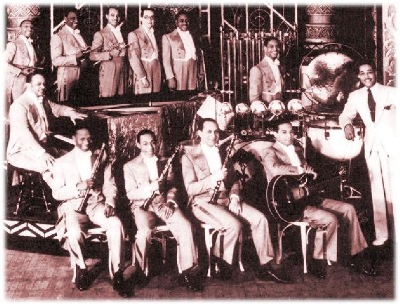
The Famous Orchestra in
Chicago, 1932
Pt. 2 - Duke Ellington and his Famous Orchestra Live
ELLINGTON LIVE 2A.mp3
C-JAM BLUES -- Duke Ellington and his Famous Orchestra, c. 1953-54
AT SUNDOWN -- Duke Ellington and his Famous Orchestra, c. 1953-54
SULTRY SERENADE -- Duke Ellington and his Famous Orchestra, c. 1953-54
THE MOOCHE -- Duke Ellington and his Famous Orchestra, 1940
HARLEM AIRSHAFT -- Duke Ellington and his Famous Orchestra, 1940
KO-KO -- Duke Ellington and his Famous Orchestra, 1940
NEVER NO LAMENT -- Duke Ellington and his Famous Orchestra, 1940
STOMPY JONES -- Duke Ellington and his Famous Orchestra, 1940
ELLINGTON LIVE 2B.mp3
OH, BABE MAYBE SOMEDAY -- Duke Ellington and his Famous Orchestra, 1938
THE GAL FROM JOE’S -- Duke Ellington and his Famous Orchestra, 1938
RIDIN’ ON A BLUE NOTE -- Duke Ellington and his Famous Orchestra, 1938
THE WEST INDIAN INFLUENCE -- Duke Ellington and his Famous Orchestra, 1943
A LIGHTER ATTITUDE -- Duke Ellington and his Famous Orchestra, 1943
ROCKIN’ IN RHYTHM -- Duke Ellington and his Famous Orchestra, 1940
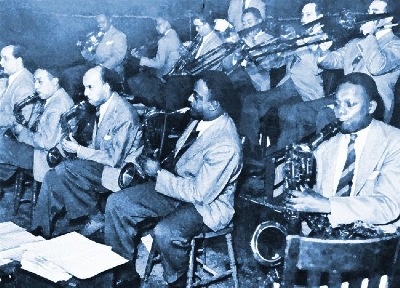
Harlem's finest
in Fargo, 1940
Pt. 3 - Duke Ellington and his Famous Orchestra Live
ELLINGTON LIVE 3A.mp3
CONGA BRAVA -- Duke Ellington and his Famous Orchestra, 1940
COTTONTAIL -- Duke Ellington and his Famous Orchestra, 1940
JUST SQUEEZE ME -- Duke Ellington and his Famous Orchestra, 1955
LAY-BY -- Duke Ellington and his Famous Orchestra, 1963
TULIP OR TURNIP -- Duke Ellington and his Famous Orchestra, c. 1953-54
BASIN STREET BLUES -- Duke Ellington and his Famous Orchestra, Berlin 1959
SLAPPIN’ SEVENTH AVE WITH THE SOLES OF MY SHOES -- Ellington Orchestra, 1938
DOWNTOWN UPROAR -- Duke Ellington and his Famous Orchestra, 1938
ELLINGTON LIVE 3B.mp3
JAM-A-DITTY (CONCERTO FOR FOUR JAZZ HORNS) -- Duke Ellington Orchestra, 1947
FRANKIE AND JOHNNY -- Duke Ellington and his Famous Orchestra, 1945
KINDA DUKISH/ROCKIN’ IN RHYTHM -- Duke Ellington Orchestra, 1963
You'll find four more programs about Duke Ellington, here.
Duke Ellington’s Famous Orchestra in Live Performance
Early on Duke Ellington and his band discovered there was a significant difference in energy between their studio sessions and sit-down concerts . . . versus dance dates. Some of the drive and swing they had when playing for dancers was missing in theatricals, stage shows, or the 3:00 minute constraints of the recording disc and studio. Fortunately, ever since the mid-1930s excellent live recordings of Duke Ellington’s Famous Orchestra were preserved on extended transcription discs, acetates, and eventually audiotape.
Ellington was a brilliant, prolific, adventurous, inventive, charming, gifted, hard-working and influential jazz musician. And he was a major composer. Duke wrote and recorded hundreds, possibly thousands of tunes, performed all over the world and maintained a continuously working band for more than four decades.
Solely as a bandleader and pianist he could be considered among the premier jazz musicians of the 20th Century, other accomplishments aside. From its inception at Harlem’s Cotton Club, Ellington's "Famous Orchestra" set the highest standards for musicality, cutting edge solo improvisation, presentation and imaginative musical ideas.
One of America’s greatest composers, among his thousands of tunes were several popular standards. Ellington was continuously advancing innovative ideas in melody, harmony and form. He employed only the finest soloists who often found their best moments in his band.

Hot in Harlem . . . or Fargo, North Dakota
During the late 1920s and early '30s Ellington's orchestra achieved wide fame, at first from his residency at, and broadcasts from the Cotton Club in Harlem. Later, they were special guests there when not touring or performing elsewhere. Good recordings of their Cotton Club broadcasts from the ‘30s are part of this body of work, and feature some of his most illustrious stars: Cootie Williams (trumpet), Johnny Hodges (alto sax), Barney Bigard (clarinet), Harry Carney (baritone sax), and singer Ivie Anderson.
Oddly, North Dakota in the 1940 was site for a remarkable live Ellington session. It was an unseasonably warm November in North Dakota that year, a balmy contrast after returning from frigid Winnipeg in Manitoba, Canada.
It was captured by young music enthusiasts Jack Towers and Richard Burris who brought a disc recorder to the Fargo, North Dakota Crystal Ballroom. As the concert proceeded and musicians heard some of the playbacks, they rose to the occasion.
The results captured the orchestra at a moment of peak creativity. Excerpts have occasionally been issued on LP or CD, yet are only well-known among true Dukeophiles. It's arguably their best live recording before the modern era, despite the recent departure of trumpeter Cootie Williams. Williams' loss to Ellington was such a big deal in 1940 that bandleader Raymond Scott wrote a popular ditty, “When Cootie Left the Duke.”
But only days before the Fargo date Ellington had hired the multiply talented Ray Nance who ably took Cootie’s trumpet chair, and he had recently added bassist Jimmy Blanton, tenor sax giant Ben Webster, and arranger Billy Strayhorn.
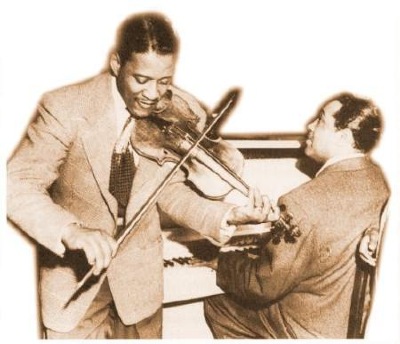
Duke and
"Floor Show"
Ray Nance
A consistent hit, Ray Nance was a unique talent who filled many roles for Duke. The diminutive vocalist, dancer, multi-instrumentalist and over-sized personality was a fine trumpeter, superb jazz violinist, and beguiling singer. The lengthy, thunderous applause and encores he received often halted concert proceedings for several minutes.
Said Duke:
“Ray Nance never played a bad note in his life. . . . Many is the time, when other members fell short, that he jumped into a substitute spot . . . he worked beyond the call of duty . . . and is a pure artist at heart.”
The admiration was mutual. Ray said,“there’s no type of music I’d rather play than Duke Ellington’s.”
A compact 5’ 4”, he was a big performer. His crowd-pleasing antics won him the nickname “floor show.” Ray Nance was arguably the most popular singer Duke ever presented in live performance.

Portland Birthday Concerts and Results of the “Great James Robbery”
Among the notable performances on these programs are the rarely issued “Birthday Sessions,” recorded at McElroy's Ballroom in Portland, Oregon. A series of performances from late April 1953 & 54: Duke’s birthday is April 29th. They’re notable for capturing the live excitement of the Ellington orchestra during an era of otherwise dreary recordings. This content was drawn directly from rare broadcast audiotapes of the event.
In the Ellington orchestra musicians stayed an exceptionally long time, often decades. It was said that you could still be “the new guy” after five years. But in 1951 the triple departures of Duke's biggest star, Johnny Hodges, trombonist Lawrence Brown (a nearly 20 year veteran), and drummer Sonny Greer who had been with him for 3 decades, was a shock.
Duke's rebound was surprisingly robust. Recovering from the blow, he quickly raided the Harry James band. In what the music press called “The Great James Robbery” Ellington hired away alto saxist Willie Smith and energetic young drummer Louie Bellson, a veteran of the Dorsey and Goodman bands; and he rehired his former valve trombonist, Juan Tizol.
Also on the roster for Portland were several notable Ellingtonians: reed players Russell Procope, Jimmy Hamilton, Paul Gonsalves, and Harry Carney; trombonists Quentin Jackson and Britt Woodman; and trumpeters Cat Anderson, Ray Nance and Clark Terry.
Striving for Something Larger
A full representation of Ellington's concertizing must include his extended works. From the late 1930s onward he strove to create a more expansive frame for his music, attempting to fuse it with the larger body of formal art music. By the 1940s his composing, arranging and concertizing had moved well beyond the conventions of jazz and swing: not only in his extended suites and tone poems, but the bold originality of his arranging and adventurous harmonic experimentation.
Ellington sought to tell, “the history of the Negro in America” through extended compositions: “Harlem,” “Liberian Suite,” “New World a Comin',” “Deep South Suite,” and most ambitious of all, the forty-five minute tone poem “Black, Brown, Beige.” Yet within his complex composing and arranging Duke always made room for jazz: masterful solo improvisation, spirited call and response, and collectively devised head arrangements
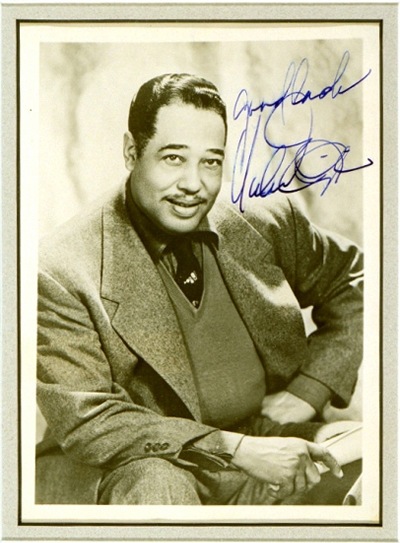
"We do love
you madly."
A Global Citizen
The live performances of Ellington’s Famous Orchestra were rarely surpassed in studio recordings. Duke loved to travel and the orchestra loved performing. They may have toured more often, more widely, further and longer than any swing orchestra of that era. His music was unique for its range, invention, depth and wide appeal. There was a special magic and electricity at their performances.
Like his life and music, the extant body of recorded Ellington concerts and live dates comprise a unique body of work 'beyond category.' Duke Ellington was a master at bonding and connecting with an audience. He spoke gently, quietly, flatteringly, drawing an audience into an intimate circle summed up in his catch phrase, “We love you madly.”
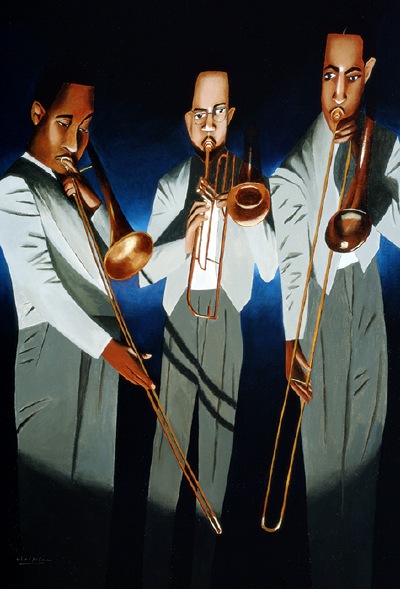
Duke's T-bones
by <I>Mark Ulriksen</I>
LINKS:
Three more JAZZ RHYTHM programs about <B>Ellington</B><B><BR><BR></B>Duke Ellington at Fargo, 1940 live
The Duke Ellington Society
Official website of Duke Ellington
Ellington at Ken Burns Jazz/PBS
Tip Jar
This site is free. But you can help sustain it, and encourage me with donation to the tip jar.
Donations are paid securely through PayPal.
Donation $5.00
Donation $10.00
Donation $20.00
Donation $35.00
Donation $50.00
Donation: You decide

